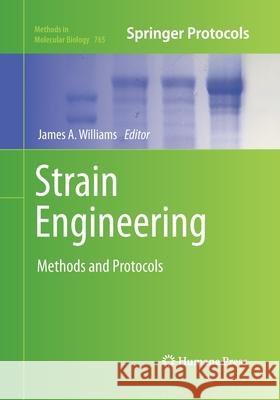Strain Engineering: Methods and Protocols » książka



Strain Engineering: Methods and Protocols
ISBN-13: 9781493958467 / Angielski / Miękka / 2016 / 480 str.
Strain Engineering: Methods and Protocols
ISBN-13: 9781493958467 / Angielski / Miękka / 2016 / 480 str.
(netto: 422,69 VAT: 5%)
Najniższa cena z 30 dni: 424,07
ok. 22 dni roboczych
Dostawa w 2026 r.
Darmowa dostawa!
This book presents powerful new genetic engineering-based strain engineering methods for rational modification of a variety of model organisms. It contains key notes and implementation advice from the experts.
Wydanie ilustrowane
Part 1. E. coli
1. Bacterial Genome Reengineering
Jindan Zhou and Kenneth E. Rudd
2. Targeted Chromosomal Gene Knockout using PCR Fragments
Kenan C. Murphy
3. Scarless Chromosomal Gene Knockout Methods
Bong Hyun Sung, Jun Hyoung Lee, and Sun Chang Kim
4. Random Chromosomal Gene Disruption In vivo using Transposomes
Les M. Hoffman
5. Genome Engineering using Targeted Oligonucleotide Libraries and Functional Selection
Elie J. Diner, Fernando Garza-Sánchez, and Christopher S. Hayes
6. Microarray-based Genetic Footprinting Strategy to Identify Strain Improvement Genes after Competitive Selection of Transposon Libraries
Alison K. Hottes and Saeed Tavazoie
7. Optimization of Synthetic Operons using Libraries of Post-Transciptional Regulatory Elements
Daniel E. Agnew and Brian F. Pfleger
8. Marker Free Chromosomal Expression of Foreign and Native Genes in E. coli
Chung-Jen Chiang, Po Ting Chen, Shan-Yu Chen, and Yun-Peng Chao
9. Array-based Synthetic Genetic Screens to Map Bacterial Pathways and Functional Networks in Escherichia coli
Mohan Babu, Alla Gagarinova, and Andrew Emili
10. Assembling New E. coli Strains by Transduction using Phage P1
Sean D. Moore
Part II. Saccharomyces cerevisiae
11. Yeast Bioinformatics and Strain Engineering Resources
Audrey L. Atkin
12. Delete and Repeat: A Comprehensive Toolkit for Sequential Gene Knock-out in the Budding Yeast Saccharomyces cerevisiae
Johannes H. Hegemann and Sven Boris Heick
13. Genome-wide Transposon Mutagenesis in Saccharomyces cerevisiae and Candida albicans
Tao Xu, Nikë Bharucha, and Anuj Kumar
14. Signature-tagged Mutagenesis to Characterize Genes Through Competitive Selection of Barcoded Genome Libraries
Julia Oh and Corey Nislow
15. Global Strain Engineering by Mutant Transcription Factors
Amanda M. Lanza and Hal S. Alper
16. Genomic Promoter Replacement Cassettes to Alter Gene Expression in the Yeast Saccharomyces cerevisiae
Andreas Kaufmann and Michael Knop
Part III. Strain Engineering Other Industrially Important Microbes
17. Microbial Genome Analysis and Comparisons: Web-based Protocols and Resources
Medha Bhagwat and Arvind A. Bhagwat
18. Plasmid Artificial Modification: A Novel Method for Efficient DNA Transfer into Bacteria
Tohru Suzuki and Kazumasa Yasui
19. Broad-host-range Plasmid Vectors for Gene Expression in Bacteria
Rahmi Lale, Trygve Brautaset, and Svein Valla
20. Simple Method for Introducing Marker-free Deletions in the Bacillus subtilis Genome
Takuya Morimoto, Katsutoshi Ara, Katsuya Ozaki, and Naotake Ogasawara
21. Transposon-mediated Random Mutagenesis of Bacillus subtilis
Adam C. Wilson and Hendrik Szurmant
22. Integrative Food Grade Expression System for Lactic Acid Bacteria
Grace L. Douglas, Yong Jun Goh and Todd R. Klaenhammer
23. ClosTron-mediated Engineering of Clostridium
Sarah A. Kuehne, John T. Heap, Clare M. Cooksley, Stephen T. Cartman, and Nigel P. Minton
24. High Throughput Transposon Mutagenesis of Corynebacterium glutamicum
Nobuaki Suzuki , Masayuki Inui, and Hideaki Yukawa
25. Mini-Mu Transposon Mutagenesis of Ethanologenic Zymomonas mobilis
Katherine M. Pappas
26. Engineering Thermoacidophilic Archaea using Linear DNA Recombination
Yukari Maezato, Karl Dana, and Paul Blum
27. Targeted Gene Disruption in Koji Mold Aspergillus oryzae
Jun-ichi Maruyama and Katsuhiko Kitamoto
28. Selectable and Inheritable Gene Silencing through RNA Interference in the Unicellular Alga Chlamydomonas reinhardtii
Karin Van Dijk and Nandita Sarkar
Classical methods for microbial strain engineering, used to improve the production of bioproducts, have serious drawbacks and have been found to be unsuitable for complex strain development applications. In Strain Engineering: Methods and Protocols, powerful new genetic engineering-based strain engineering methods are presented for rational modification of a variety of model organisms. These methods are particularly powerful when utilized to manipulate microbes for which sequenced and annotated genomes are available. Collectively, these methods systematically introduce genome alterations in a precise manner, allowing the creation of novel strains carrying only desired genome alterations. In the first section, E. coli-based bacterial strain engineering strategies are reviewed, while the second section presents analogous microbial engineering strategies for eukaryotic cells using the yeast Saccharomyces cerevisiae as a model. The third section covers examples of the proliferative adaptations of these base technologies to strain engineer industrially important prokaryotic or eukaryotic microbial systems. Written in the highly successful Methods in Molecular Biology™ series format, chapters contain introductions to their respective topics, lists of the necessary materials and reagents, step-by-step, readily reproducible laboratory protocols, and notes on troubleshooting and avoiding known pitfalls.
Authoritative and accessible, Strain Engineering: Methods and Protocols serves as an ideal guide to scientists in academia, pharmaceutical science, and biotechnology who perform microbial strain engineering.
1997-2025 DolnySlask.com Agencja Internetowa
KrainaKsiazek.PL - Księgarnia Internetowa









